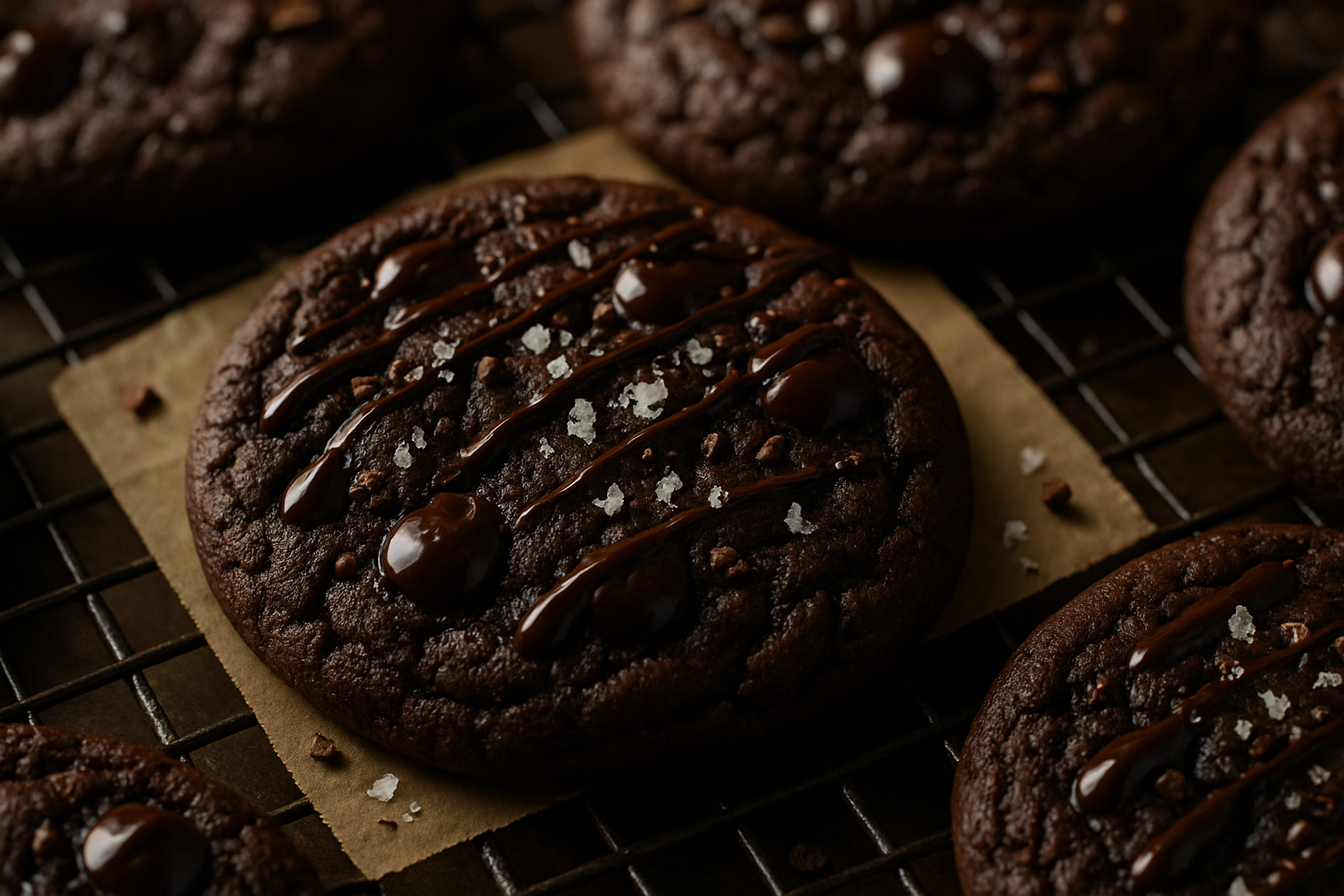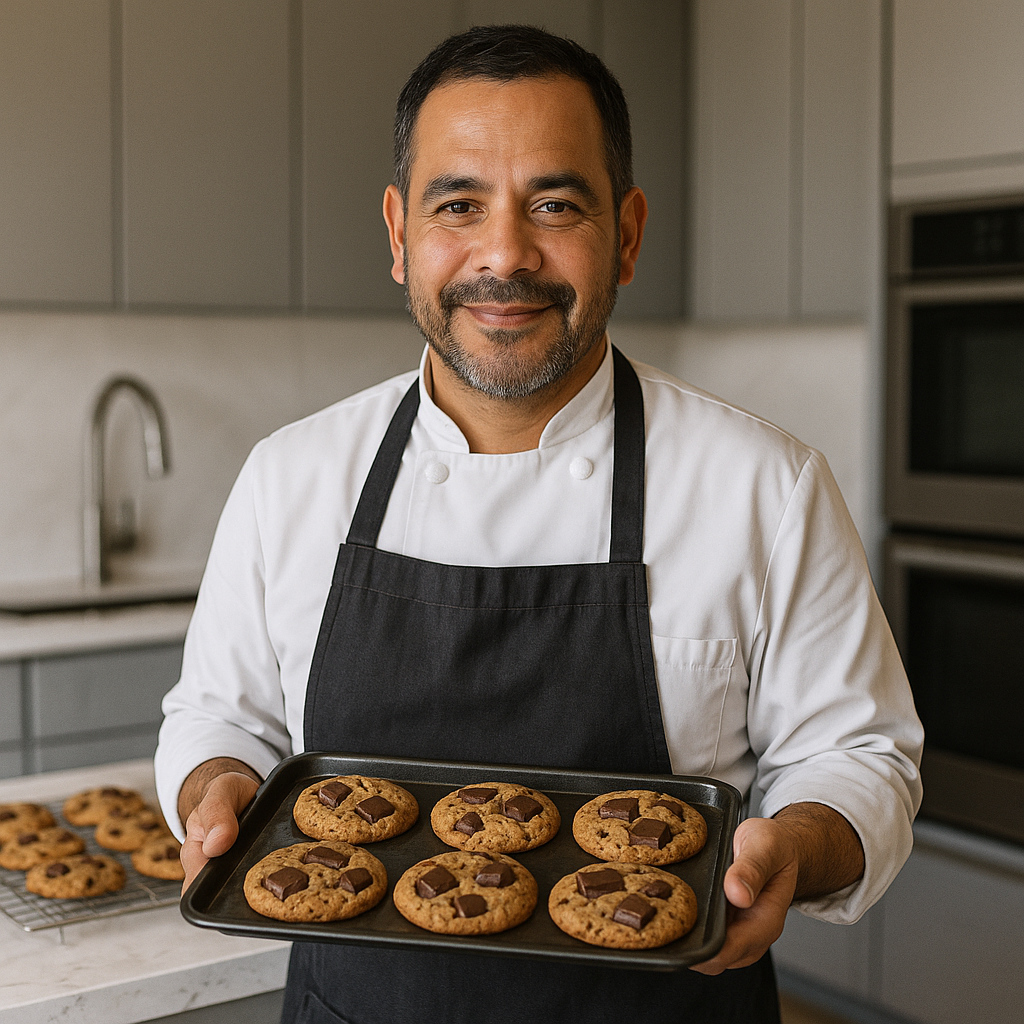You want a cookie that bakes up predictably rich, with bold chocolate in every bite and a texture you can dial from chewy to crisp. This method is built for that level of control. I rely on an exacting test-kitchen approach: gram weights for consistency, clear visual cues, and notes that explain how to nudge spread, crinkle, and chew. That combination removes guesswork and helps you bake a reliable batch the first time and every time after. We keep the process straightforward, but precise, so you can focus on results, not jargon .
There’s a reason I insist on Swiss chocolate: the melt is smooth, the sweetness is balanced, and the flavor is consistent across brands. Those attributes translate into dependable pockets of chocolate that soften, set, and re-melt beautifully in the oven. When we build a dough around that quality, the cookie’s structure holds while the chocolate delivers an even, satisfying bite. Every recipe on my site is built on the same principle—Swiss-first chocolate, tested for cocoa percentage, format (bar, feves, chips), and melt behavior—so we can give you exact guidance on how the chocolate will perform in your oven .
We also validate parameters that matter: rack position, oven temperature, and timing are tested methodically, then summarized so you don’t have to run experiments at home. By the time you follow this method, the path is proven. You’ll see cues like edges set, centers with a slight dome, and the sheen level on the chocolate—practical, repeatable markers of doneness. This is the same disciplined approach I apply across the site, from mixing sequence to make-ahead steps. It’s a focused process that gives the swiss dark chocolate chip cookies recipe real-world reliability in your kitchen .
Key benefits of the swiss dark chocolate chip cookies recipe
Here’s what you gain by using this approach at home:
- Consistent results: Using gram weights removes ambiguity from measuring. Your dough behaves the same from batch to batch, producing dependable spread and texture .
- Swiss-first chocolate guidance: You’ll know which cocoa percentage to buy and whether to use bars, feves, or chips, along with how each format affects melt pools and structure .
- Clear step cues: Visual and tactile markers (like dough sheen, stiffness, and edge set) help you stay on track without second-guessing timing .
- Make-ahead flexibility: Chilling and freezing notes let you fit baking into your schedule without sacrificing quality. You’ll get exact instructions for chilling, portioning, and storing the dough .
- Swap guidance when needed: If you must use a non‑Swiss option, I show you how to match cocoa %, fat content, and format to keep results steady, along with realistic expectations for any differences .
In short, the swiss dark chocolate chip cookies recipe is engineered for home bakers who want trustworthy, repeatable cookies with robust chocolate character. You’ll get a strong structure, balanced sweetness, and the ability to tune chewiness—without complicated techniques. This focus on clarity and repeatability makes the method a smart baseline to master and a solid template for your own variations later .
Ingredients for the swiss dark chocolate chip cookies
Before we mix, let’s align on ingredients and why each one matters. You’ll see I specify weights and give format notes for the chocolate so you can hit the right texture target.
- Swiss dark chocolate (chips, feves, or chopped bars): Choose a balanced cocoa percentage that melts smoothly without turning oily. Swiss chocolate’s consistent melt and flavor make it ideal for even pockets and clean slices if you share or store leftovers .
- Butter: I prefer European‑style butter for its fat content and reliable creaming performance; it supports better spread control and a richer crumb .
- Granulated and brown sugar: We use a deliberate ratio to manage caramelization, moisture, and chew. Adjusting this balance is one of the fastest ways to tweak texture .
- Eggs (or tested egg‑free binders): For egg‑free versions, I rely on proven binders like aquafaba or ground flax and explain texture expectations up front .
- Flour: A standard all‑purpose flour base supports structure. I provide brand or blend guidance for gluten‑free alternatives when relevant, including notes on xanthan use .
- Leavening and salt: Calibrated for lift without puffing the cookies into cakiness. Salt sharpens chocolate notes.
- Vanilla: Small amount, steady impact; it rounds out the dark cocoa profile.
When you follow the swiss dark chocolate chip cookies recipe, you’ll also see guidance on matching cocoa percentage and format if you’re substituting chocolate. That way, even if you can’t source your first choice locally, you can still achieve a stable dough and reliable melt behavior .
Tools and equipment for the swiss dark chocolate chip cookies
You don’t need a commercial setup to get professional‑level consistency. Here’s a concise list with reasons each item matters.
- Digital scale: Measuring in grams is the most reliable path to consistent dough and repeatable texture. It’s how all my methods are tested and documented .
- Mixing bowls and a sturdy spatula: You’ll cream, fold, and scrape with confidence. A flexible spatula helps prevent undermixing or dry pockets along the bowl’s edges.
- Stand mixer or hand mixer: Either works. We use controlled creaming to trap the right amount of air and manage spread during baking .
- Half‑sheet pans: Reliable heat distribution and room for spaced portions. Line with parchment for clean release and even bottoms.
- Cookie scoop: Portioning ensures consistent diameter and thickness, which directly impacts bake time and texture.
- Oven thermometer: Verifies your actual oven temp. Small deviations can cause over‑spread or underbaked centers.
- Cooling racks: Finishes carryover cooking without steaming the bottoms.
These tools support the same test‑kitchen standards I use for every recipe—clear steps, measured inputs, and repeatable outcomes. Keeping gear simple and reliable means you can execute the swiss dark chocolate chip cookies recipe at home without special equipment or guesswork .
Step-by-step dough mixing for the swiss dark chocolate chip cookies
We’ll keep the technique direct and practical, with visual cues so you know exactly what “right” looks like.
- Cream butter and sugars: Beat until the mixture looks slightly lighter and feels fluffy but not airy. This sets spread and edge definition. If it smears rather than lifts, chill the bowl briefly.
- Add eggs and vanilla: Mix until smooth and cohesive. Look for a satiny sheen—no streaks. This is your signal to stop and avoid overmixing.
- Whisk dry ingredients separately, then add: Combine flour, leavening, and salt. Mix on low just until no dry spots remain. Overmixing here toughens the crumb.
- Fold in Swiss dark chocolate: Use a spatula to distribute chips, feves, or chopped bars evenly. You want uniform pockets of chocolate throughout the dough for consistent bites .
- Chill (recommended): A short chill tightens the dough, improves flavor, and helps control spread. I include exact chill windows and make‑ahead notes with the method so you can plan your bake day .
- Portion: Scoop onto a lined sheet, spacing evenly for airflow and uniform browning.
I document step cues in all of my methods (texture, sheen, and timing signals) so you can follow the swiss dark chocolate chip cookies recipe with confidence—no mystery steps, no vague “mix until ready” language. The goal is precise, readable directions that deliver the same result in your kitchen as they do in mine .
Baking time and temperature guide for the swiss dark chocolate chip cookies
Oven behavior is the final variable, so we keep the targets clear and scalable. I test across rack positions and temperature ranges to define a narrow window that works consistently at home. You’ll see a preferred middle‑rack position and a temperature that delivers set edges and soft centers without greasiness. I also note a slightly hotter option if you want more crinkle and a quicker set, with timing adjustments to prevent overbaking .
Watch for these markers:
- Edges set, centers slightly domed: Pull when the centers still look soft; carryover heat finishes the middle.
- Chocolate sheen: The surface gloss on the chocolate tells you it’s melted properly and will re‑set into glossy pockets.
- Even bottoms, light browning: Parchment helps prevent hot spots and encourages clean release.
If you’re chasing chewier cookies, shorten the bake a touch; for crisper edges, extend by a minute, keeping a close eye near the end. The swiss dark chocolate chip cookies recipe includes a make‑ahead path with clear chilling and freezing guidance so you can bake straight from the freezer with a small time adjustment. Those notes help you hit your preferred texture on your schedule, without trading off flavor or structure .
Recipe Notes and FAQs list
Can I use non‑Swiss chocolate? Yes. Match cocoa percentage, fat content, and format (chips/feves/chopped bars). Expect subtle differences in melt and sweetness. I provide a simple swap guide so you can keep outcomes stable when you can’t source your first choice .
Are gluten‑free or egg‑free versions supported? Absolutely. I specify GF blends by brand or formula and include notes on xanthan use. For egg‑free bakes, I list proven binders like aquafaba or ground flax with texture expectations, so you know what will change and what stays the same .
Why grams instead of cups? Grams deliver consistency. That’s how I test, document, and publish recipes—so your experience at home mirrors my fifth test bake, not a first attempt with guesswork. It’s a key reason the swiss dark chocolate chip cookies recipe is so repeatable .
Do you include nutrition information? I include approximate values for convenience, but they’re estimates only. Ingredient brands and portion sizes can vary; use those numbers as a starting point rather than a clinical data point .
Storage and freezing tips: Cool completely, then store in an airtight container. For longer storage, freeze portions of dough or fully baked cookies; I include clear instructions on chilling, freezing, and thawing to maintain flavor, spread, and crumb integrity .
Any other pro tips? Keep an oven thermometer in place, rotate sheets if your oven has hot spots, and avoid overcrowding pans. Small, exacting tweaks like these add up to a strong, reliable finish. Use them as your standard playbook whenever you bake the swiss dark chocolate chip cookies recipe at home .


